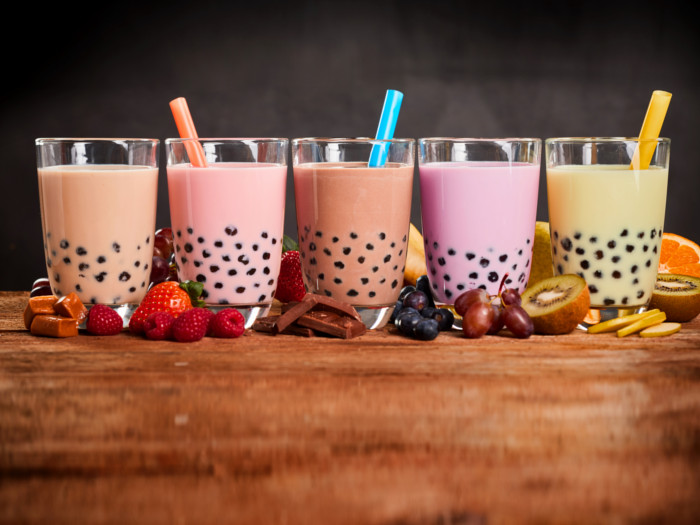Bubble tea is a tea-based beverage that has quickly spread past its native boundaries of Taiwan. Initially popular with Taiwanese schoolchildren, it is now becoming a favorite among adults for its sweet taste, unique ingredients, and for its huge range of flavors.
What is Bubble Tea?
Bubble tea, also known as pearl milk tea, boba juice, boba tea, and bubble milk tea, is a Taiwanese tea-based drink. It is also called tapioca tea, as tapioca balls are the main ingredient in this tea. [1]
Boba tea consists of a tea base (white, green, or black) that is mixed or shaken with milk or other fruits, and fruit jelly or tapioca balls are added, which sink to the bottom. Ice is often blended into the mixture, which results in a slushy or smoothie consistency. There are different fruits and flavors that can be used in bubble tea and the most popular varieties are bubble milk tea and bubble milk green tea.
Combined with the variety of teas, the amount of milk, and the choice of fruit jelly or tapioca pearls, there are thousands of combinations of bubble tea. Each of these has different nutrient compositions, which offer excellent health benefits. [2]
Types of Bubble Tea
- Fruit flavored teas: Widely available fruit-flavored bubble teas are prepared using strawberries, mangos, green apples, lychee, watermelons, grapes, pineapples, bananas, cantaloupes, kiwifruits, and jackfruits.
- Milk teas: There are milk alternatives used to make a healthier version of bubble tea. Condensed milk, non-dairy creamer, soy milk, low-fat milk, coconut milk, and almond milk are some of the tasty, yet healthy, milk substitutes that blend well into the bubble tea.
- Hybrid fruit milk teas: A combination of fruits, jellies, and milk is offered in hybrid bubble teas. This beverage-cum-dessert is one food you can customize and relish the way you wish to!
The sweet and original nature of this tea has brought it to more than 30 countries, as well as more than 800 tea stores in the United States alone. Before you dig into this growing trend of this tea, it’s important to understand everything about this tasty treat.

Bubble tea is a Taiwanese recipe made by blending tea with milk, fruit, and fruit juices. Photo Credit: Shutterstock
Taste
The taste of bubble tea is completely dependent on the fruit flavors or syrups that you choose to include in your drink, as well as the base flavor of the tea and the fruit jellies you add in the bottom. The flavors can range from saccharine and sweet to earthy and nutty, with some varieties even being slightly bitter or sour.
Calories
Research indicates that a single serving of boba milk tea with tapioca balls contain approximately 299 calories and 38 gms of sugar. [3]
Is Bubble Tea Good For You?
Bubble tea can be good for you if you choose the right ingredients and avoid adding excess sugar to the beverage. In an average tea store, it will often include condensed milk and additional sugar, boosting the overall calorie count of the drink and pushing it into the unhealthy realm. However, there are healthier ways to prepare this beverage, particularly if you are making it for yourself at home.
Benefits
This exotic tea has many benefits that include the following:
May Boost Energy
Owing to the sugar in bubble tea, in addition to the caffeine that is found in black, white or green tea, this popular Taiwanese drink can provide a major boost in energy. While you don’t want to overdo this beverage, given its high calorie and sugar count, a healthier version with less sugar could still provide a kickstart to your metabolism. [4]
May Strengthen Immune System
Green tea, one of the most popular flavors of bubble tea, contains a wide range of potential antioxidants such as catechins and polyphenols, all of which can boost the immune system by preventing oxidative stress. Furthermore, if you choose fresh fruits in your tea such as mango, strawberry or kiwi, you will also get a dose of vitamin C in your tea, meaning even more of a boost to the immune system. [5]
May Prevent Free Radical Damage
The polyphenols and epigallocatechin found in green bubble tea can have impressive effects on the free radicals floating around your body. These free radicals may cause mutation and lead to chronic diseases, so adding green tea to your diet is always a good choice. However, further research and studies are required. [6]
A sugar-rich diet is not always good for your cardiovascular health, but in the case of boba tea, if you prepare a healthy version, the potentially antioxidants and anti-inflammatory compounds found in the tea may help maintain a healthy body and heart. [7]
Note: These health benefits are largely negated when you drink a normal, sugar-rich and calorie-heavy bubble tea. Creating your own healthier versions at home is highly suggested if you want to enjoy any of these effects.
Side Effects of Bubble Tea
Due to the ingredients and inherent nature of this tea, there are some side effects that people may want to avoid. [8]
Weight Gain: Regular consumption of bubble tea, without adjustments in calorie intake in other areas, may result in weight gain. If you combine the fruit syrup, sweetened condensed milk and tapioca balls to a glass of bubble tea, the calorie count can often climb past 350 calories, which is on the higher side. [9]
Diabetes: Due to the high levels of sugar and the fact that tapioca balls are a rich source of carbohydrates, this beverage isn’t recommended for people who have diabetes or are at high risk for developing that condition. [10]
